Donaldson's Hospital, Edinburgh, Scotland
Donaldson's Hospital was founded by the bequest of James Donaldson, an Edinburgh publisher, who died in 1830. Construction began in 1842 of what had originally been envisaged as an asylum for destitute children. However, one of the gentlemen elected as a governor of the new establishment, George Forbes, who had acquired an interest in the education of deaf children, suggested that part of the building might be reserved for the deaf. The idea gained momentum and also won the support of the head of the Edinburgh Institution for the Deaf and Dumb, Robert Kinniburgh, and his counterpart at the Glasgow Institution, John Anderson. In July 1848, it was resolved that one side of the Hospital containing 96 beds should be set aside for the reception of deaf children. Other regulations included that: no children should be admitted before the age of seven and that they must leave at fourteen; that a separate committee of five governors entitled the Committee of Education for Deaf and Dumb Children' should be set up, to whom the 'master of the deaf and dumb' should be responsible for the education of these children. The person appointed to this post was Angus McDiarmid, a teacher from London's Asylum for the Support and Education of the Deaf and Dumb Children of the Poor.
The Hospital, designed by William Henry Playfair, occupied a site at the north side of West Coates and took over eight years to complete. The location and layout of the building are shown on the 1894 map below.
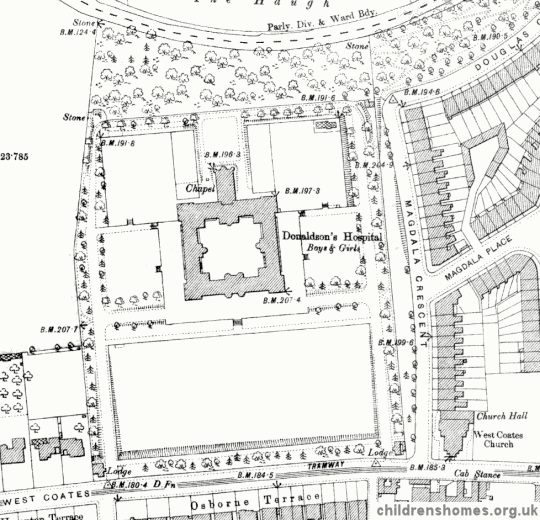
Donaldson's Hospital site, Edinburgh, c.1894.
When the institution opened on 16 October 1850, fifteen deaf boys, and two days later fifteen deaf girls, chosen from the list of 133 applicants were admitted. By February 1851, the total number of deaf pupils had increased to 40.
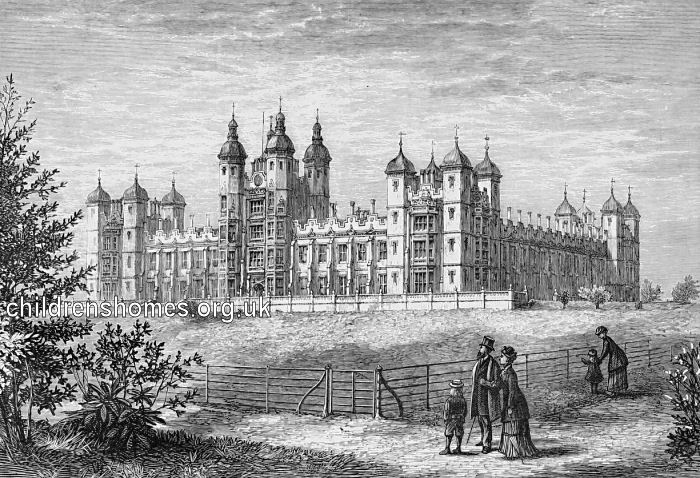
Donaldson's Hospital, Edinburgh, from the south-east, c.1850.
The palatial character of the Hospital building attracted some criticism, as indicated by the the following press report from the time:
Hospitals for Poor Children.
A very favourite place of resort at present strangers visiting Edinburgh, Donaldson's Hospital, the magnificent building standing about half a mile to the west the city, seen on the left when approaching in the train from Glasgow. This building is, in respect of its external, not less than its internal construction, certainly the greatest monument reared in modern times to the genius of one man in Scotland. It has cost, we believe, considerably more than half a million sterling; and some idea may be formed of the extent of its accommodation when we state that there are upwards of eight miles of wooden panelling upon its walls. The founder is the late James Donaldson, printer of the present Edinburgh Advertiser newspaper, and the architect is Mr. W. P. Playfair. The building was begun 1842, and now nearly ready for the reception of its inmates — several hundreds, namely, of poor children of both sexes, of whom a certain portion are deaf and dumb. The education of these is to conducted by highly-salaried teachers, and every comfort will be paid to them. Indeed, as Carlyle said of the cleanness of the model prison, so it may be said of the comfort of this model hospital, no nobleman's house in the land has more. Examining the dormitories, see that each little bed has its toilet-bag attached, containing comb, hair-brush, toothbrush, and clothes-brush. Each little lady and gentleman has a pair of house shoes and walking shoes. Their dresses are extremely neat, and every appliance that can make community healthy and happy here, — careful attendance, spacious play-grounds, baths, &c. We have omitted to speak of the chapel, which contains splendid window of stained glass, each compartment representing a Christian virtue. It is the work of Mr. James Ballantine, the well known glass-stainer, and received the high approbation of her Majesty when she lately visited it. The advantages of such a splendid institution as this are by no means obvious. Reared in a palace, with every comfort and convenience, the children who are to be received to the benefits of this great institution will certainly not be the better fitted, by their early training, for fighting their way through a world which does not value man by the whiteness of his teeth or the cleanness of his hands. {Cetera desunt.)—Ayr Observer. [We have not ourselves yet seen the interior of this palace for poor children, but have been informed that the toilet bag, in addition to the articles before enumerated, also contains a nail brush. After this, we should not be surprised to hear of the introduction of silver plate into the institution. Verily the happy juveniles may be said to have been born with a silver spoon in their mouths.]
Despite the suggestion in the article, the cost of the building was in the region of £200,000.
Donations to the Hospital allowed the number of children increased from 40 in 1851 to 118 in 1880, with a corresponding increase in the staff. Angus McDiarmid retired in 1863 and was briefly succeeded by James Tait. His replacement was Alfred Large, who, like McDiarmid, came from the London Institution and who remained as the Hospital's principal teacher of the deaf until his retirement in 1899.
Although the original suggestion had been for a nine years' course, it, in fact, was generally from five to seven years duration, since children were not admitted until the age of seven and had to leave at fourteen. The children were supplied with clothes — the boys a dark blue suit with brass buttons, and the girls a tartan dress — and the conditions of life seen to have been lie those in similar institutions.
On Saturdays, children over ten could visit their friends in Edinburgh from 9 a.m. till 6 p.m. Whilst the younger ones were allowed out on the first and third Saturdays of the month, and could be visited on the other days s. On Sundays the hearing children attended church twice a day, but the deaf children were only required to attend morning service. In the afternoon they assembled in their classes where they received religious instruction from their own teachers. The church at West Coates was built largely as a, result of the needs of the Hospital.
It was generally considered that mixing deaf and hearing children was advantageous to both — thee deaf were given a preparation for living in the hearing world, and the hearing in appreciating the difficulties of the non-hearing.
Although physical education did not become general in ordinary schools until the early 1900s, in the early 1860s at Donaldson's drill classes for the boys had started to be given by an ex-army drill sergeant. From the Hospital's earliest years, the children who did not go hone for the summer holidays were taken twice a week in carts to bathe sea at Granton. Drawing seems to have been introduced into the curriculum at Donaldson's around this date. In 1867, the desks were specially fitted for drawing, and in 1870 the drawing master gave separate drawing lessons to the deaf pupils.
In 1873, the children's timetable in the was as follows:
| DEAF-MUTE TIMTEABLE—2D CLASS | |||||||
|---|---|---|---|---|---|---|---|
| 8.45-9.15 | 9.15-10.15 | 10.15-10.45 | 12-1 | 2-3 | 3-3.30 | 3.30-4 | |
| MONDAY | Children say Sunday Lesson. |
Dictation. |
Children as Questions. |
Questions and Writing. |
Arithmetic. |
Nouns. |
Object Lesson. |
| TUESDAY | Say Nouns, Object Lesson, and Catechism. | " | Easy Questions. | " | " | Verbs. | " |
| WEDNESDAY | Verbs, and Object Lesson. | Writing Exercises. | Writing Exercises. | Writing Exercises. | Old Test. Questions. | Explain Chapter of Bible. | Religious Lesson and Catechism. |
| THURSDAY | Religion, Nouns, and Catechism. | Dictation. | Miscellaneous. | Children as Questions, and Writing. | Arithmetic. | Adjectives. | Object Lesson. |
| FRIDAY | Adjectives, Object Lesson, and Geography. | Writing Exercises. | Writing Exercises. | Writing Exercises. | " | Learn Exercises. | Learn Exercises. |
| Sunday.—Preparation on Sundays, 9.15-10 A.M. Church.—11-12.30 A.M. Boys' and Girls' Preparation every evening, except Friday, 7-8 P.M. Friday.—Senior Division Draw Maps, 7-8 P.M. Junior Division, Drawing, 7-8 P.M. School on Sundays, 2.30-4, New Testament Lessons, etc. Sunday Evenings, 5.30-6.30, to learn Bible Lesson. Senior Division, Reading Lesson, 5-6 P.M. Thursday. | |||||||
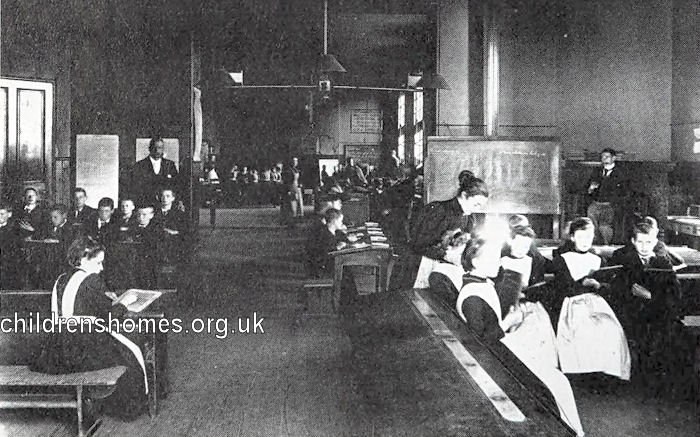
Classroom at Donaldson's Hospital, Edinburgh, c.1895.
At that date, no vocational training was provided at Donaldson's as Alfred Large believed that the pupils required all their time for the learning of language. Large claimed to use what he called the "combined" method of instruction, in which the children spent a certain amount of time learning articulation, but the main method of instruction was by signs, finger-spelling, and writing. When children were admitted to the Hospital, teaching was begun by means of the manual alphabet and pictures, followed by writing. Written language and the manual alphabet were the main ways in which the children were taught to express themselves grammatically, and the standard of work attained was high. Articulation, was taught to a varying extent depending on the capabilities of the pupils in that direction. Despite the emphasis on non-vocal communication, Donaldson's was the one school in Scotland at that time where speech was taught, even to a limited degree. After Large departed in 1899, he was was succeeded by John Brown, who had been his principal assistant. In the early 1900s, there was greater use of the oral method. Those pupils showing a particular aptitude for it were placed in special classes and taught by the oral method.
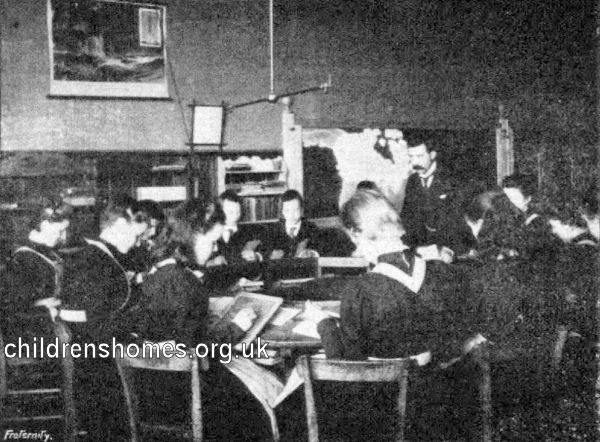
Oral Class at Donaldson's Hospital, Edinburgh, c.1911.
In 1895, it was decided to allow the deaf children to remain at school until they were 16. This was to allow the boys to have a period of technical training and the girls of domestic training.
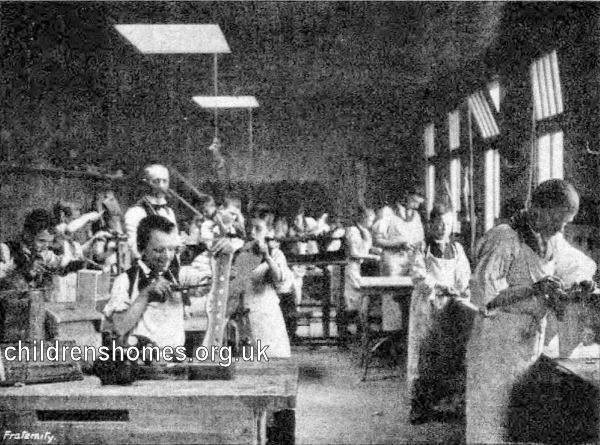
Workshop at Donaldson's Hospital, Edinburgh, c.1911.
In the early 1900s, the boys' uniform of dark blue jacket with brass buttons was replaced by a Norfolk suit, while the girls gave up their tartan dresses for something more comfortable and less conspicuous.
In 1930, a government Commission of Educational Endowments concluded that the maintenance of two separate schools for the deaf in Edinburgh was both educationally and economically unsound, and proposed that Donaldson's should amalgamate with the Institution for the Deaf and Dumb. Hearing children would cease to be admitted to the latter and the combined endowments of the two institutions would be amalgamated for the sole purpose of providing an efficient education for deaf children. The scheme was strenuously opposed by the Governors of Donaldson's Hospital who believed that it would destroy the Donaldson system of associating deaf children with those of normal hearing. A revised scheme was eventually accepted and the merger took place on 1 August 1838, the new institution being named Donaldson's School for the Deaf. The Henderson Row site became the School's junior department and the Donaldson's Hospital site at West Coates became the senior department, with a major new building added to it facilities.
At the outbreak of the Second World War in 1939, the School sent its Edinburgh children to Dunglass House in East Lothian. About two months later, this became the home of the senior department, while the junior department from Henderson Row was installed at Redcroft Hotel in North Berwick. The school operated at these two locations until 1946.
In 2008, the School moved its operations to a new campus at Preston Road, Linlithgow. Both the Henderson's Row and West Coates buildings have now been converted to apartments.
Records
Note: many repositories impose a closure period of up to 100 years for records identifying individuals. Before travelling a long distance, always check that the records you want to consult will be available.
- National Library of Scotland, 92 Cowgate, Edinburgh EH1 1JN, Scotland. Extensive holdings include admission registers, petitions, lists of applications (mainly printed), reports, and recommendations for admission (1850–1916), many with annotations. For details see the full inventory.
Census
Bibliography
- Higginbotham, Peter Children's Homes: A History of Institutional Care for Britain's Young (2017, Pen & Sword)
- Pritchard, D.G., Education and the Handicapped 1760-1960 (1963, Routledge & Kegan Paul)
- Watson, J, Instruction of the Deaf and Dumb (1809)
- Watson, Thomas J., A History of Deaf Education in Scotland 1760-1939 (Unpublished PhD Thesis, University of Edinburgh, 1949)
Links
Except where indicated, this page () © Peter Higginbotham. Contents may not be reproduced without permission.


